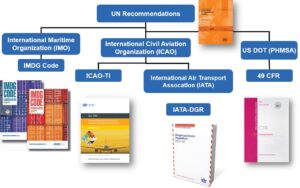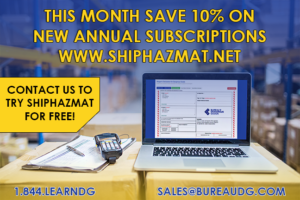
We’ve heard the saying many times, the world is becoming a smaller place. Fewer and fewer companies have customers only within the country they are headquartered. Those that do, find themselves interpreting the dangerous goods international regulatory requirements even when shipping an overnight package from one city to another within a country. Why is that?
When digging deeper, one might find similarities in hazmat shipping regulations between countries. Some more than others. When researching dangerous goods airline regulations, the question of what is the difference between ICAO and IATA? Which set of regulations are used when shipping a cargo container from China to the United States? What is an orange book?
There are many benefits to understanding the dangerous goods international regulatory structure. First, it is knowing which set of regulations to turn to in order to move a dangerous goods shipment across a country or between countries. Also, knowing where regulations come from can help a Dangerous Goods Specialist prepare for a change long in advance of its effective date. Finally, understanding dangerous goods regulatory requirements is critical to being able to apply for special authorizations or request a needed change to the regulations.
Where Do Dangerous Goods International Regulatory Requirements Start?
There are two places where regulations start. One is within the competent authority of a country. In the case of the United States, the Pipeline and Hazardous Materials Safety Administration (PHMSA) within the Department of Transportation (USDOT) is responsible for writing and enforcing hazardous materials regulations. Many regulations start with the United Nations Sub-Committee of Experts on the Transport of Dangerous Goods. These regulations are published in the United Nations Model Regulations (Model Regulations or Orange Book). We’ll look at PHMSA first.
Pipeline and Hazardous Materials Safety Administration (PHMSA)
As mentioned earlier, PHMSA is the agency within the US DOT responsible for writing and enforcement of the hazardous materials regulations within the United States. Each sovereign nation may create and enforce its own set of regulations. There are many reasons for a country to have regulations that are not harmonized with the rest of the world including national security, infrastructure differences, and attitudes toward safety and the environment. Most countries, the United States included, work to keep their hazmat regulations harmonized with global regulations for safety and trade.
The USDOT regulations for transporting hazardous materials are found in the 49 CFR Parts 100 – 185. The print version of these regulations is updated annually on October 1. An electronic version of the regulations is updated as needed.
Changes to the dangerous goods regulations must be announced to the public through a notice in the Federal Register. PHMSA may publish notices in several forms in the Federal Register. Advanced Notices of Proposed Rulemaking (ANPRM) are high-level publications of proposed changes to regulations that are intended to get early feedback on upcoming revisions. Notices of Proposed Rulemaking (NPRM) are draft amendments to regulations that the public can comment on. Final rules (FR) are amendments to the regulations that will appear in the next edition of the 49 CFR.
The Hazardous Material Regulations (HMR: 49 CFR Parts 100-185) are the regulations to be followed when shipping dangerous goods into, out of, or through the United States. Most shippers spend most of their time in the 49 CFR in Parts 172 and 173. It is important to get to know the early sections in the regulations (Parts 100 – 171). In these sections are found PHMSA’s authority to promulgate and enforce regulations, how to petition PHMSA, investigation information, and information on fines and penalties should things go wrong. Take a few minutes to look through this often ignored area.
Most of PHMSA’s regulations come from the UN Model Regulations. This is done to facilitate international trade and keep shipments moving through the transportation system efficiently. PHMSA also allows the use of other international regulations for preparing shipments under certain conditions, normally involving the mode of transport. Permission for the use of other regulations is found in Part 171.22 through 171.26. Make sure to reference these sections whenever a dangerous goods international shipment is being prepared as there are some exceptions for their use.
PHMSA also works closely with the authorities of some of the United States’ closest trade partners.
United Nations Model on Dangerous Goods International Regulatory Guidelines
The United Nations Model Regulations on the Transport of Dangerous Goods provide a basis for the development of harmonized regulations for all modes of transport, to facilitate trade and the safe, efficient transport of dangerous goods. The Model Regulations facilitate compatibility between modal requirements so that a consignment may be transported by more than one mode without intermediate reclassification, marking, labeling, or repackaging.
Member nations, known as the UN Sub-committee of Experts on the Transportation of Dangerous Goods, meet twice a year to review and vote on proposed changes to the dangerous goods international regulatory requirements. National authorities and certain interested parties submit papers for review and debate by the sub-committee. If an agreement can be made, the changes put forth in a paper will be incorporated into the next edition of the Model Regulations. The Model Regulations are updated every two years.
Once the Model Regulations are updated, national authorities may choose to update their regulations as needed. The Model Regulations may only be mandated if a country has adopted them or incorporated them into their existing regulatory structure.
International Civil Aviation Organization (ICAO)
ICAO is responsible for the publication of the Technical Instructions for the Safe Transport of Dangerous Goods by Air (Technical Instructions or “TI”). Nations are required to put forth legislation, in compliance with the Technical Instructions, to provide a global system of harmonized regulations for the safe transportation of dangerous goods by air. The Dangerous Goods Panel, made up of national authorities is responsible for updating the TI. New editions are published every two years.
The ICAO TI are based on the UN Model Regulations. Nations also publish “State” variations to the regulations that apply to shipments moving in, out, or through the State.
Though the TI are the legal source material for shipping dangerous goods by air internationally, most shippers are more familiar with the IATA Dangerous Goods Regulations (DGR). The International Air Transport Association (IATA) is an industry group to which most of the world’s airlines are members. The DGR are based on the ICAO TI with operational considerations incorporated in them. These considerations often result in more restrictive requirements by airlines for shipping dangerous goods. To transport dangerous goods on most airlines (even domestic flights), the shipment must comply with the DGR. For this reason, shippers are more familiar with the IATA DGR than the ICAO TI.
International Maritime Organization (IMO)
IMO is responsible for maintaining the International Maritime Dangerous Goods (IMDG) Code. The IMDG Code is the set of regulations for most of the dangerous goods shipments made by water. The purpose of the IMDG Code is to protect the crew and prevent marine pollution. The IMDG Code is based on the UN Model Regulations and contains additional maritime-specific requirements like marine pollutants.
Similar to ICAO, implementation of the IMDG Code is mandated by an international treaty. More than 150 countries have signed on to the treaty, making 98% of the world’s gross tonnage regulated by the IMDG Code.
The IMDG Code is updated every two years. Unlike the ICAO TI, there is a one-year transitional period between editions during which either published edition of the Code made be used. This allows shippers and operators time to become familiar with new requirements.
International Atomic Energy Agency (IAEA)
IAEA publishes regulations for the shipment of radioactive materials. These regulations are not updated regularly. When they are updated, they are sent to the UN for incorporation into the Model Regulations. The IAEA regulations are then adopted by the modal agencies and national authorities.
Stay Up-to-Date With the Latest Dangerous Goods International Regulatory Requirements With Hazmat University!
As you can see, there is an expansive system in place to protect people, property, and the environment from dangerous goods incidents. The cooperation of nations and the network of trade and industry organizations is vital to keeping commerce moving and the world safe.
Whether it’s the latest hazmat rules and regulations or recurring hazmat certification courses, Hamzat University has you covered! Explore our course menu or reach out to our team at (844) 427-0167 to learn how you and your team can stay confident, competent, and compliant!
Promotion for May!


ShipHazmat – Subscribe for a Free Trial Today
http://www.ShipHazmat.net